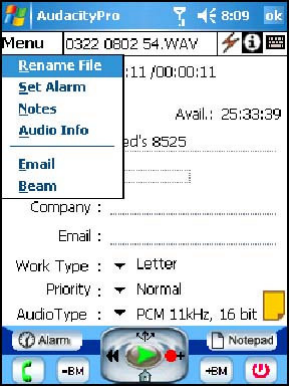
Audacity
©2008 Audacity Audio Page 24 of 29
Menu from Record and Playback Screens
Rename File
Provides a method to rename the open file.
Set Alarm
Access to the Audio Alarm Set screen to set an alarm for the
open file. Tapping the alarm icon on the screen will also open
this window. A hardware button may also be programmed to
access the alarm.
Audio Info
Provides information about the open audio file and allows for
editing. For example, the action could be change to put the file
in hold status.
Email
Provides a way to email an audio file as an attachment.
Beam
Provides a way to Beam a file to another Audacity user.
Conduit Details And Where To Find Your Files
Audacity Pro includes a conduit to make it easy to transfer the recorded files to the PC. New files get
transferred automatically as part of a normal Sync. In ActiveSync under Tools, Options, look for
AudFilePro. Make sure it is checked for the conduit to transfer your files.
The default file location is C:\Program Files\Audacity Professional DVR PPC\Incoming\. Under this will be
the same structure that the files are located on the handheld. For instance: SD Card\Audacity
Pro\Record\0324 0840 45.WAV.
If you are unsure whether a file got transferred or not, a log file is kept of all activity. The file includes a
timestamp and the complete path of the transferred file. To access this file, go to the ActiveSync window
and click on Tools and Options. Select AudFilePro and click the Settings button. This opens an Audacity
Conduit Window. The Audacity Conduit keeps two log files. The current one is highlighted. Click it to open
the current log file. Scroll to the end to view the most current activity. When this file gets over 64 KB the
log will transfer to the other file. When that file becomes full, the first log file is deleted and a new log file is
started. These files are kept under C:\Program Files\Audacity Personal DVR PPC\Incoming.
